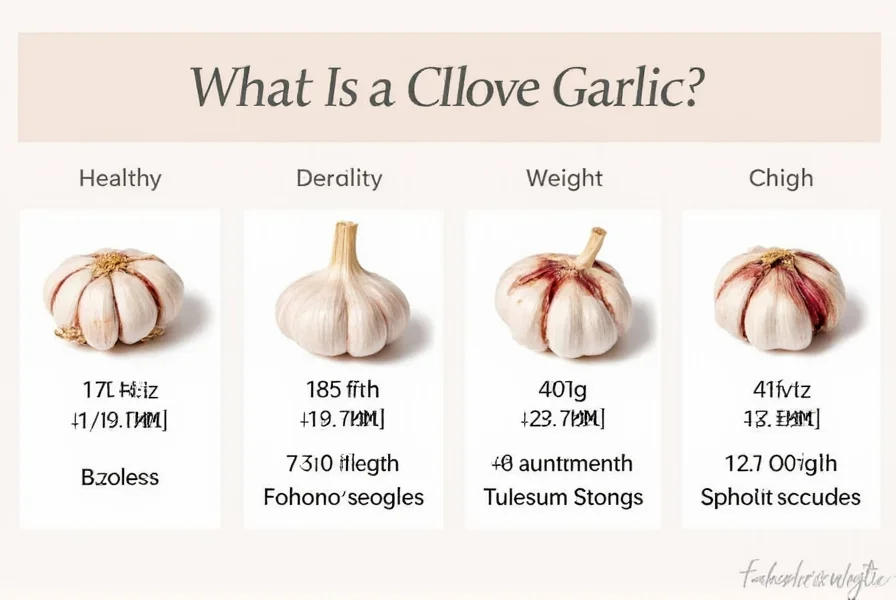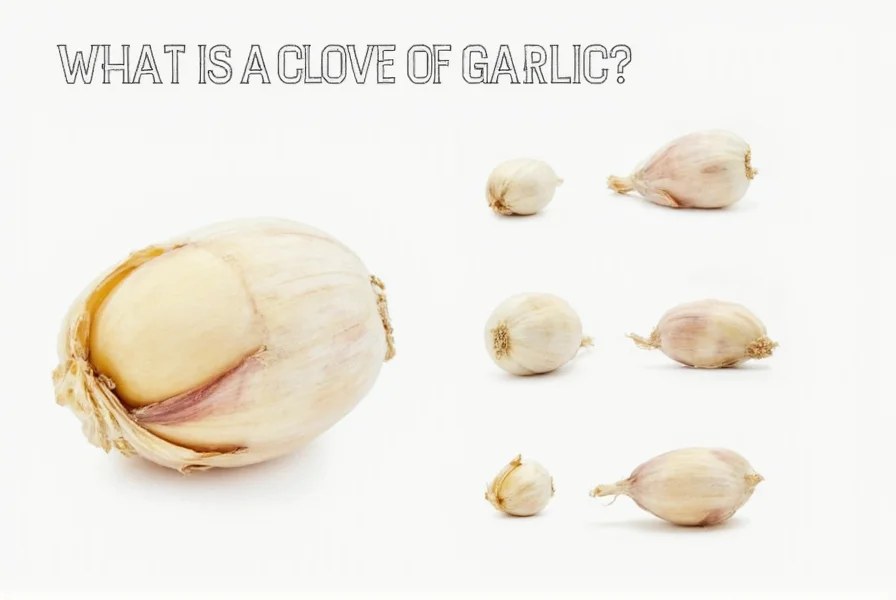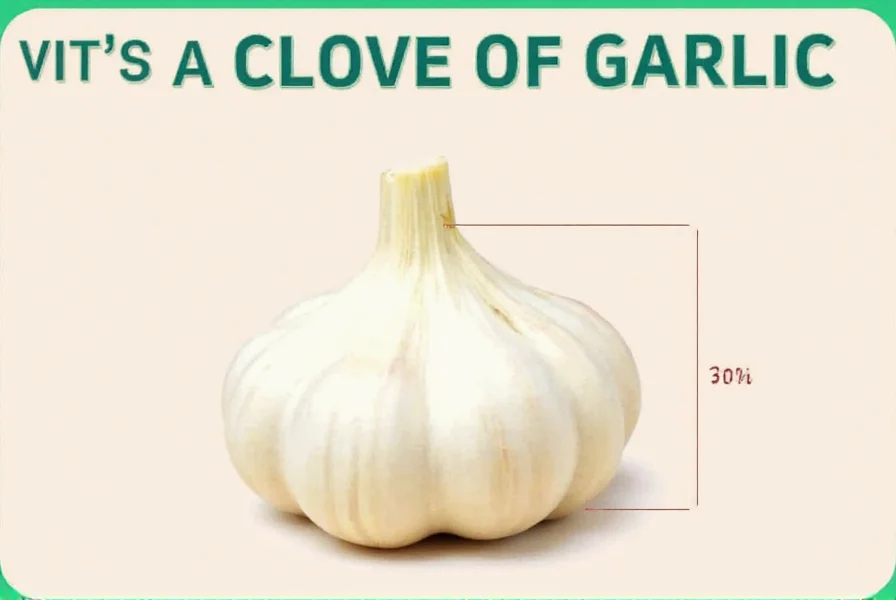Understanding the precise measurement and characteristics of a single garlic clove is essential for both novice and experienced cooks. This small but mighty ingredient plays a crucial role in cuisines worldwide, yet many home chefs struggle with accurate measurements and substitutions when recipes specify “a clove of garlic.” Let's explore everything you need to know about this fundamental cooking component.
Physical Characteristics of a Garlic Clove
A garlic bulb, commonly called a “head” of garlic, typically contains 10-20 individual segments known as cloves. Each clove is encased in its own papery skin and has a pointed end with a flat base where it connected to the bulb's central stem.
| Characteristic | Measurement |
|---|---|
| Average weight | 3-7 grams |
| Length | 1-2 inches (2.5-5 cm) |
| Width | 0.5-1 inch (1.3-2.5 cm) |
| Peeled weight | 2-5 grams |
Size varies significantly depending on garlic variety and growing conditions. Larger varieties like Elephant garlic produce substantially bigger cloves, while some heirloom varieties feature smaller segments.

Nutritional Profile of One Garlic Clove
Despite its small size, a single garlic clove packs a nutritional punch. According to USDA data, one average 3-gram raw garlic clove contains:
- Calories: 4-5 kcal
- Carbohydrates: 1 gram
- Protein: 0.2 grams
- Fiber: 0.1 grams
- Vitamin C: 0.4 mg (1% of daily value)
- Vitamin B6: 0.04 mg (2% of daily value)
- Manganese: 0.03 mg (1% of daily value)
- Selenium: 0.3 mcg (1% of daily value)
Garlic also contains allicin, the compound responsible for many of garlic's potential health benefits, though the exact amount varies based on preparation method.
Culinary Measurements and Conversions
Understanding garlic clove measurements is critical for recipe accuracy. Here's how one average clove translates to common kitchen measurements:
| Preparation Method | Yield from One Clove |
|---|---|
| Minced garlic | 1/2 teaspoon |
| Finely chopped | 3/4 teaspoon |
| Crushed (with press) | 1/2 teaspoon |
| Garlic powder substitute | 1/8 teaspoon |
| Bottled minced garlic | 1/2 teaspoon |
These conversions for how much minced garlic equals one clove help ensure recipe consistency. Remember that larger cloves will yield more, while smaller ones produce less. When precision matters, especially in delicate sauces or dressings, consider weighing your garlic for the most accurate results.

Health Considerations of Consuming Garlic
While one garlic clove contains modest nutritional value by standard measures, it contributes bioactive compounds with potential health benefits. Research suggests that allicin, formed when garlic is chopped or crushed, may support cardiovascular health and provide antimicrobial properties.
Consuming one to two cloves of garlic daily falls within typical dietary patterns in garlic-consuming cultures. Some people experience digestive discomfort when eating raw garlic, so cooking it can make it more tolerable while preserving many beneficial compounds.
Those taking blood-thinning medications should consult their healthcare provider about garlic consumption, as it may enhance the medication's effects. The nutritional value of one garlic clove, while small in caloric terms, contributes meaningful phytochemicals to a balanced diet.
Proper Storage Techniques
Once separated from the bulb, individual garlic cloves have a shorter shelf life than whole heads. For optimal freshness:
- Store peeled cloves in an airtight container in the refrigerator for up to 1 week
- Place unpeeled separated cloves in a cool, dark place with good air circulation
- Freeze whole unpeeled cloves for up to 6 months (thaw before use)
- Submerge minced garlic in olive oil and refrigerate for up to 1 week
Never store garlic in water at room temperature, as this creates conditions favorable for botulism. The shelf life of a single garlic clove decreases significantly once peeled, so plan accordingly when preparing recipes that call for just one clove.
Frequently Asked Questions
How much minced garlic equals one clove?
One average garlic clove yields approximately 1/2 teaspoon of minced garlic. Larger cloves may produce up to 3/4 teaspoon, while smaller ones might yield only 1/4 teaspoon. For precise measurements in sensitive recipes, weighing the garlic (3-7 grams per clove) provides the most accurate results.
What is the weight of a single garlic clove?
An average unpeeled garlic clove weighs between 3-7 grams, with the peeled clove weighing 2-5 grams. The weight varies significantly based on garlic variety, growing conditions, and position within the bulb (outer cloves tend to be larger). For cooking precision, especially in professional settings, weighing garlic provides more consistent results than volume measurements.
Can I substitute garlic powder for a fresh garlic clove?
Yes, you can substitute garlic powder for fresh garlic, but the flavor profile differs. As a general rule, 1/8 teaspoon of garlic powder equals one average fresh garlic clove. Keep in mind that garlic powder has a more concentrated, less complex flavor than fresh garlic, so you may need to adjust other seasonings in your recipe accordingly. For the best results, fresh garlic is preferred when possible.
How long does a single garlic clove last after peeling?
A peeled garlic clove stored in an airtight container in the refrigerator typically remains fresh for 5-7 days. At room temperature, peeled garlic begins deteriorating within 24 hours. For longer storage, freeze peeled cloves in an airtight container for up to 6 months. The shelf life of a single garlic clove decreases significantly once separated from the bulb, so plan your cooking to minimize waste when recipes call for just one clove.
What's the difference between a garlic clove and a garlic head?
A garlic head (or bulb) is the entire round cluster you purchase, typically containing 10-20 individual segments. Each segment is called a clove. The head is wrapped in a papery outer skin, while each clove has its own thin skin layer. Recipes specifying “a clove of garlic” refer to one individual segment, not the entire head. Understanding this distinction is crucial for proper recipe execution and measurement conversions.











 浙公网安备
33010002000092号
浙公网安备
33010002000092号 浙B2-20120091-4
浙B2-20120091-4